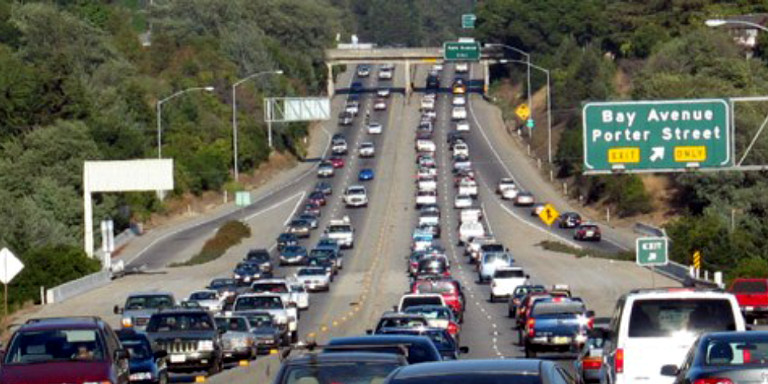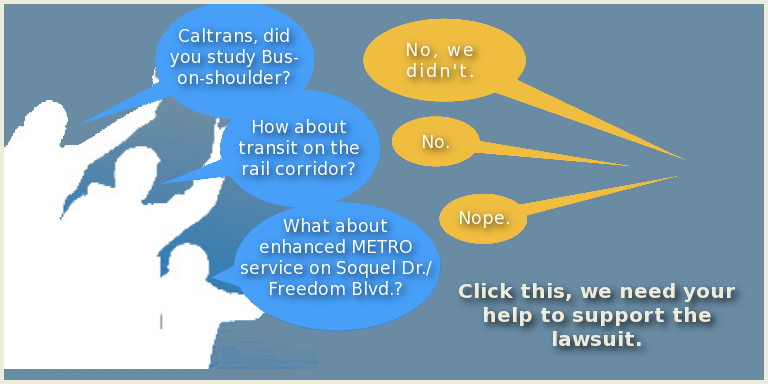Join CFST and the Sierra Club in Advocating for Sustainable Transportation—Not Highway Widening
Please help by contributing to
the lawsuit now filed by CFST and the Sierra Club.
This legal action will bring our county's transportation
policy into alignment with the California Environmental
Quality Act and state mandates to reduce greenhouse gas
emissions. When we stop highway expansion, our County's
transportation policy will no longer be guided by the
mistaken belief that the solution to traffic congestion is
expanded roads.
To make a contribution, click on
this link.
Caltrans EIR: Auxiliary Lanes Won't Reduce Congestion or Improve Safety

Aux Lane Example
Our County Regional Transportation Commission plans to spend $100 million in local sales tax money to build 4 miles of auxiliary lanes on Highway 1 from Soquel Avenue to State Park Drive. The two reasons cited by our County's Regional Transportation Plan for the project are:
- to relieve traffic congestion
- to improve safety
The auxiliary lanes will accomplish neither objective, according to Caltrans' Draft Environmental Impact Report (2015) on Highway 1 projects. The EIR analyzed a multi-faceted highway project known as the TSM Alternative, of which the 4 miles of auxiliary lanes are a subset. (Other projects in the TSM Alternative include rebuilding overpasses; rebuilding onramps; ramp metering; 3 more miles of auxiliary lanes, etc.) The EIR concludes:
- The TSM Alternative “would result in very slight improvement in traffic congestion compared to the No Build Alternative.”
- “The total accident rates overall and by segment under the TSM Alternative would be the same as the accident rates for the No Build Alternative.”
Why Does the RTC Still Propose Constructing Auxiliary Lanes?
The Regional Transportation Commission has yet to acknowledge the dissonance between the claim that the auxiliary lanes will improve safety and traffic congestion and the conclusions of the Draft EIR. When the Draft EIR was published in November, 2015, the RTC didn't ever schedule a discussion of its conclusions. CFST believes that after spending $13 million on the EIR, the RTC should carefully consider its conclusions before committing funds in a futile attempt to reduce traffic congestion.
Unofficially, some RTC members see the auxiliary lanes project as a stepping stone to the much larger project that would add High Occupancy Vehicle (HOV) lanes (carpool/ bus lanes). The artist's rendering from the Draft EIR depicts a future Highway 1 that is twice the width of the current highway, with an HOV lane and auxiliary lane in each direction. A more realistic image would show a congested highway. The Draft EIR predicts that by 2035, Vehicle Miles Traveled on the expanded highway would increase by over 50% in the morning and afternoon peak periods (6am-12pm and 2pm-8pm). Greenhouse gas emissions would rise along with vehicle miles traveled.
A San Francisco Chronicle article reports that 62% of the HOV lane-miles in the San Francisco Bay Area are degraded, leading to a proposal to increase the carpool requirement from two persons to three.
Read why vehicle miles traveled increases when highways are expanded: More Congestion!
Federal Highway Administration: HOV Project Is Not Financially Feasible
Federal Highway Administration: HOV Project Is Not Financially Feasible In May 2011 Federal Highway Administration staff met with RTC staff and CalTrans and threatened to cut off funding for the environmental assessment of the HOV lanes project and to demand repayment of some of the federal funds that had already been spent on part of that work. This was part of a general effort nationwide by Federal Highways to stop paying out money for environmental assessments and preliminary engineering on projects that had no prospect of ever getting construction funding. The RTC was able to work out a deal with Federal Highways in which local funding would contribute to the environmental review.
The HOV Project remains out of reach financially.
The HOV Project is listed as costing $600 million, but currentlythat it would cost close to a billion. Federal money for highway expansion can no longer be expected, and California has redirected its spending priorities away from highway expansion. The Regional Transportation Plan acknowledges that between now and 2040, the only money available for Highway 1 projects is $100 million in local sales tax dollars for the auxiliary lanes.
Change of Priorities Needed
In spite of the fact that there is no prospect to fund the HOV Project, the RTC named the project its "preferred alternative" in October, 2017. Until the RTC acknowledges that the HOV lane project is not viable, it may be difficult for that body to embrace public transit alternatives such as those under consideration in the RTC's Unified Corridors Study:
- Bus-on-shoulder on Highway 1
- Enhanced bus prioritization and service on Soquel Drive and Freedom Boulevard
- Transit on the rail corridor
In violation of the California Environmental Quality Act (CEQA), none of the alternatives being analyzed in the Unified Corridors Study are included in the Highway EIR analysis. CEQA requires environmental review to analyze feasible alternatives to the project. The only alternatives under consideration by the EIR (now costing close to $14 million) are the HOV Lane Project, the TSM Alternative, and the No Build Alternative.
Please help by making a contribution to fund the lawsuit.

